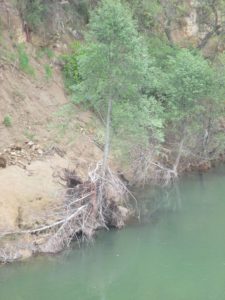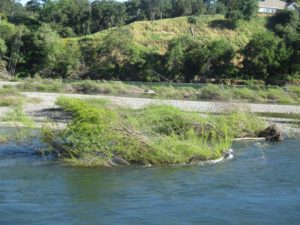Saturday April 22, 2017 8 am
During my morning walk, I hear birds greeting the day as they sing hidden in trees lining Fair Oaks Village and nearby streets. A few chickens greet me, still emerging from their evening hiding places in trees and under shrubs.
 Sun is high in the sky. Dawn arrives before 6 am on these spring mornings. The sun is already over the horizon to light the morning. Thin, scattered clouds streak the sky. The green water is calmly moving downstream. Sunlight sparkles on the water. As I stand on the bridge, I hear the deep throated cooing from unseen pigeons. The river is empty. Not even one duck is out swimming this morning. All the homes, hiding places, ridges and islands for wildlife to settle on are overrun with water. The river runs high again today and so many once dry places are still flooded.
Sun is high in the sky. Dawn arrives before 6 am on these spring mornings. The sun is already over the horizon to light the morning. Thin, scattered clouds streak the sky. The green water is calmly moving downstream. Sunlight sparkles on the water. As I stand on the bridge, I hear the deep throated cooing from unseen pigeons. The river is empty. Not even one duck is out swimming this morning. All the homes, hiding places, ridges and islands for wildlife to settle on are overrun with water. The river runs high again today and so many once dry places are still flooded.
One tree with roots exposed stands as a marker to the constantly changing water level. During the peak of winter storms, the tall, thin tree was completely surrounded by water, sitting as an island several feet from the water’s edge. Today as in many recent days past, it hugs the eroded shore, roots exposed.
Runners run and a few cyclists pass this site once filled with morning wake up activities, quacks and squabbles, splashes and dives. Today the river is empty. I sit on the bridge and later walk down to the boat launch ramp. No ducks, no Canada geese, no Egrets fly in. A few birds fly overhead as if to spy on the emptiness of the river.
Several spider webs filled with tiny insects are firmly attached to bridge rails. I take photos and they become invisible in the sun’s bright light reflecting on them from all directions. I hear two geese unseen in the distance for a few seconds and then their honking sound disappears. Today, everything here is very quiet. Aside from a few pigeons that settle on the bridge, the only movement here is the river gently flowing downstream.
 On bike rides and walks along other parts of the American River Parkway, I see Canada geese settle on the sandy banks far inland from the water’s edge finding food. A few ducks swim in more shallow areas of the river. About ¼ mile from the bridge, where I used to see ducks swimming in a narrow, shallow part of the river, dunking and eating, dunking and eating, the river is now stretched wide and deep. The water level has risen onto the adjacent strip of sandy beach. This 100-yard stretch of the river was also the ideal spot to watch salmon swim, jump the rapids and spawn.
On bike rides and walks along other parts of the American River Parkway, I see Canada geese settle on the sandy banks far inland from the water’s edge finding food. A few ducks swim in more shallow areas of the river. About ¼ mile from the bridge, where I used to see ducks swimming in a narrow, shallow part of the river, dunking and eating, dunking and eating, the river is now stretched wide and deep. The water level has risen onto the adjacent strip of sandy beach. This 100-yard stretch of the river was also the ideal spot to watch salmon swim, jump the rapids and spawn.
One of many casualties from the river flooding is this cement memorial bench bearing the quote “just another day in paradise,” flipped over on its back. Shrubs, tree branches and other debris litter the areas pushed down river by the weight of the rushing water. Branches lean and uprooted trees remain stranded in the river many weeks after flooding has subsided.
 The predominant sounds I hear today is morning traffic crossing the Sunrise Blvd. bridge. Jim’s Bridge, the popular fishing, pedestrian and bicycle bridge that crosses the river and provides an access point to the American River Parkway remains closed and fenced off. The side fences are gone. Another casualty of winter flooding. No way to know if/when this bridge will open again.
The predominant sounds I hear today is morning traffic crossing the Sunrise Blvd. bridge. Jim’s Bridge, the popular fishing, pedestrian and bicycle bridge that crosses the river and provides an access point to the American River Parkway remains closed and fenced off. The side fences are gone. Another casualty of winter flooding. No way to know if/when this bridge will open again.
Jim’s bridge is one of my favorite places to watch flaming orange sunsets spreading light over the sky as if on fire. I have also seen many thrill seekers jump from the edge. In a previous blog, the photo of a Great Blue Heron was sitting on rocks at the far end of this bridge. This bridge is also a key part of Eppies Great Race, an annual event where competitors change from cycles to kayaks. Will the bridge fence be repaired by July?
I will return again to Fair Oaks Bridge to watch if this area becomes shallow once again in days ahead. I eagerly await the return of the wildlife, not knowing if or when they will return to swim and play as they greet the new day.
